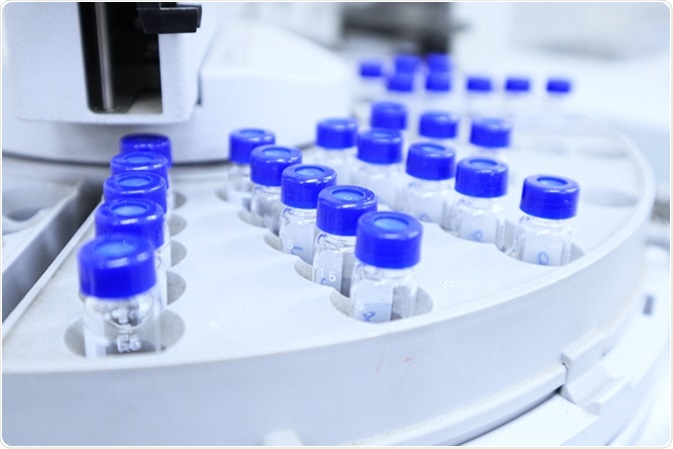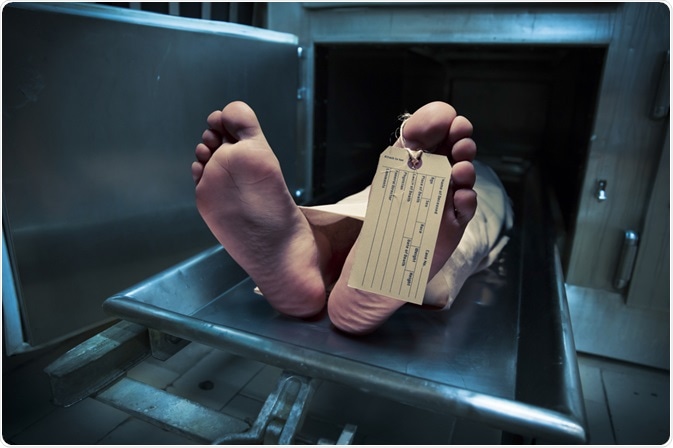Identification of Unknown Compounds
Chromatography is the process by which compounds within a mixture are separated. This can be achieved by properties such as size, and how the compounds interact with the mobile and solid phases of chromatography.
There are different types of chromatography, ranging from 2D-based (planar) methods such as Thin Layer Chromatography (TLC) and column-based methods, including Gas Chromatography (GC) and High-Performance Liquid Chromatography (HPLC).

Image Credit: Hotsum / Shutterstock.com
Running the chromatography to produce a chromatogram involves using a mobile phase (liquid or gas) over a stationary phase (solid or liquid), and the way compounds interact with the two phases causes their separation. For example, if a compound binds strongly to the stationary phase then it will move slower than another molecule that does not bind as strongly to the stationary phase.
In a planar chromatography technique, if a compound binds more strongly to the stationary phase it travels up slower than compounds that do not bind as strongly. Therefore, the distance traveled by the different compounds in a mixture is observed in the chromatogram.
In column chromatography, if a compound binds more strongly to the stationary phase then this will be eluted from (or leave) the column after compounds that do not binds as strongly. These are also said to have a longer retention time.
Use in Forensics
Planar Chromatography
Basic planar chromatography techniques can be used to identify if two ink samples are likely to be the same. For example, the ink used in two pieces of text could be compared to see if they show a similar separation in planar chromatography. As another example, a bank bill (note) can be marked with ink, and if that bill is stolen then a forensic scientist may be able to see if the same ink can be detected on the hands of the thief.
HPLC
HPLC is a column chromatography method using a solid stationary phase and a liquid mobile phase. However, unlike liquid chromatography methods where the mobile phase is slowly dripped through the column, it is pushed through the column at high pressure.
HPLC can be used to analyze explosives as different substances used in explosives have different properties, and therefore will have different retention times. Certain drugs can also be detected by HPLC.

Image Credit: Fer Gregory/Shutterstock.com
Gas Chromatography (GC)
Gas chromatography, or gas-liquid chromatography, involves using a liquid stationary phase and a gas mobile phase. In forensics, gas chromatography is used to determine if a deceased person has taken any alcohol or drugs prior to death, as well as determining if they had been poisoned. This is crucial information when trying to determine how a person has died.
Samples from the crime scene such as blood and fibers can also be analyzed with gas chromatography to aid the investigation. A report by Lu and Harrington in 2007 suggested that gas chromatography could be used to detect flammable liquids that have been used in arson.
The Detector – Coupling Chromatography to Mass Spectrometry
Chromatography methods need a way to detect the compounds, as the technique itself only acts to separate them. Commonly, samples that are eluted from liquid or gas chromatography can then be put through a mass spectrometer, which separates the charged particles by their size. Using a chromatography method coupled to mass spectrometry can therefore effectively narrow down the range of possible compounds that an unknown substance might be.
While gas chromatography-mass spectrometry (GC-MS) has been established in forensics, the use of liquid chromatography-mass spectrometry (LC-MS) is something that has been established more recently. The development of LC-MS techniques means that compounds that cannot be analyzed by GC-MS can now be identified by using this technique instead.
Gas Chromatography/Mass Spectrometry
Further Reading